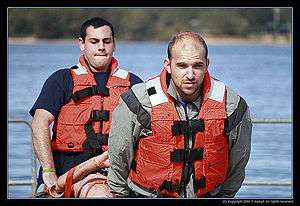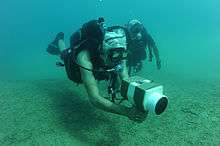Underwater search and recovery
Underwater search and recovery is the process of locating and recovering underwater objects, often by divers.[1] but also by the use of submersibles, remotely operated vehicles and electronic equipment on surface vessels.


Most underwater search and recovery is done by professional divers as part of commercial marine salvage operations, military operations, emergency services, or law enforcement activities.[2][3]
Minor aspects of search and recovery are also considered within the scope of recreational diving.
Professional search and recovery


The scope of professional search and recovery includes the following applications:
- Marine archeology - search for artifacts of historical interest and importance, and where applicable the recovery of such artifacts for study.
- Marine salvage - search for lost material of value and recovery thereof
- Environmental protection - search for environmentally undesirable material and disposal thereof
- Forensic S&R - search for and recovery of material relevant to police investigations
- Emergency S&R - Search for and recovery of victims of accidents and disasters
- Military S&R - Search and recovery related to military operations and material
- Scientific S&R - search for objects of scientific interest, recovery of instrumentation and samples
Recreational search and recovery
Search and recovery diving is also frequently undertaken as part of recreational diving, and most diver training organisations have dedicated training courses on the subject. Search and recovery is generally considered a more hazardous speciality diving course.[nb 1]
Underwater search and recovery used to form a mandatory component of the Advanced Open Water Diver training course for many North American diver training agencies,[nb 2] which, in addition to learning basic search and recover skills, also assisted in teaching students to cope with task loading.
Although the scale, value and equipment used in commercial and recreational search and recovery are enormously different, the basic premise remains the same in each case.
Search
Diver search

Underwater searches, much like above water searches, are designed around specific search patterns. The most common forms of underwater search patterns are:
- Circular search
- Jackstay search
- Expanding square search
- "U" pattern search
The patterns are usually performed by divers in pairs or teams below the water, but they can also be conducted by use of a tender who may be a snorkeller at the surface, a person on a towing boat, or a person located on the shore.
In simple search operations, the patterns will usually be conducted by the divers simply looking visually for the object. In more sophisticated search operations, underwater magnetometers or hand held sonar may be used.
Types

Diver training traditionally divides searches into two categories, specific and non-specific.
A specific search is an attempt to locate a known object in a known area where it was believed to be lost even if the time period is undefined, and the search terminates upon the location of the object. The classic example of this would be an item lost overboard from a boat, which needs to be recovered.
A non-specific search is a search for either a type of object or anything valuable within the dive locale. Usually the discovery of a relevant object does not usually terminate the search until the entire search area has been covered, or the search terminates early for other reasons (air supply, no decompression limits, etc.).
ROV searches
Searches using non-visual methods
- Magnetometers
- Side-scan sonar
- Draglines
- Cadaver dogs
Recovery

Recovery techniques depend upon the type and size of the object.
Smaller objects, such as a coin or camera, can simply be carried up by the diver. Training agencies vary in what they specify to be the maximum weight that can be safely carried up unassisted, but normally the limit is set around 15 pounds (7 kg). Anything heavier represents a material change to the diver's buoyancy control, and may put the diver at risk from an uncontrolled ascent if contact with the object is lost during ascent.
Medium-sized objects are normally recovered using a lifting bag, and students are trained in lifting bag technique. The most common hazard is entanglement with lines whilst filling the lifting bag from the diver's alternate air source. This risk, when coupled with the possibility of rapid ascent following the freeing of the object from suction caused by it resting upon the sea bed, can seriously compromise the safety of the recovery team if done improperly. Lift bags can be rated up to several tons, but these are beyond the capacity of most recreational divers. A cubic metre of air per tonne at ambient hydrostatic pressure is needed. This is not practicable for cylinders carried by the diver (the most common scuba cylinder size has a total capacity of 80 cubic feet (2.3 m3) at surface pressure.)
Significantly larger objects usually require specialised commercial lifting equipment, either a winch attached to a boat or platform, or specialised equipment to seal and inflate sunken vessels.
See also
- Underwater searches – Techniques for finding underwater targets
- Diver navigation, also known as Underwater navigation – Underwater navigation by scuba divers
- Underwater archaeology – Archaeological techniques practiced at underwater sites
References
- PADI (2003). PADI Search & Recovery manual. ASIN: B000YPP84E. United States: PADI.
- US Navy (2006). US Navy Diving Manual, 6th revision. United States: US Naval Sea Systems Command. Retrieved 2008-06-15.
- NOAA Diving Manual, 4th Edition CD-ROM prepared and distributed by the National Technical Information Service (NTIS)in partnership with NOAA and Best Publishing Company
Footnotes
- For example, PADI regards search and recovery as one of only three speciality which require the student to already be certified as an Advanced Open Water Diver before commencing (the other two being ice diving and cave diving, both of which are considered highly hazardous).
- For example, it was a mandatory part of the PADI Advanced Open Water Diver course until 1989